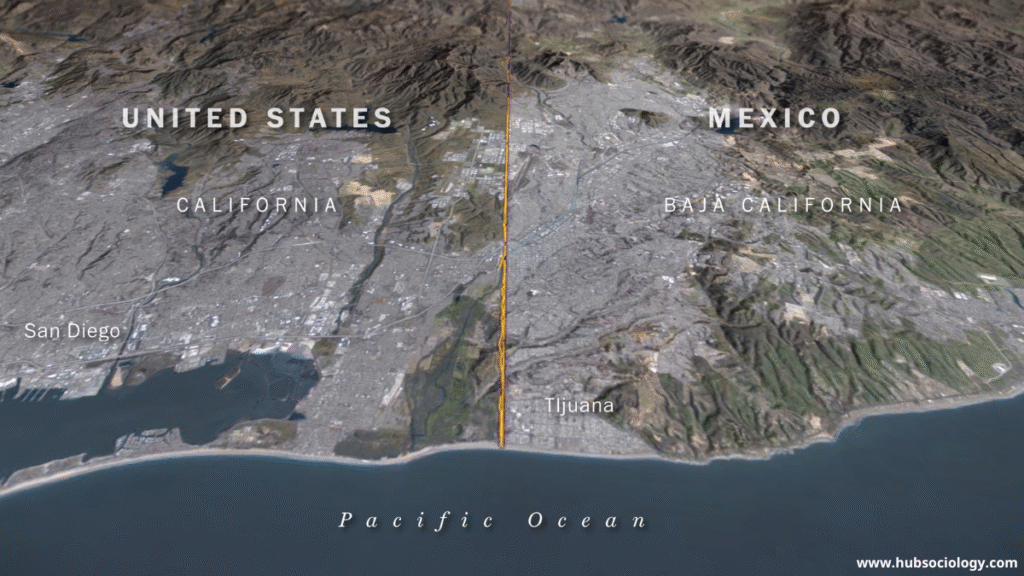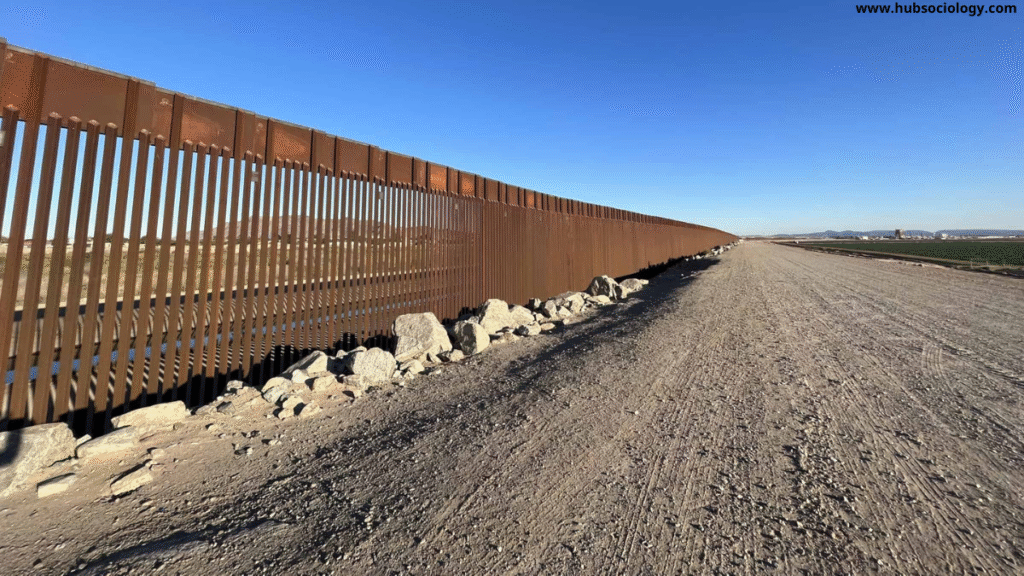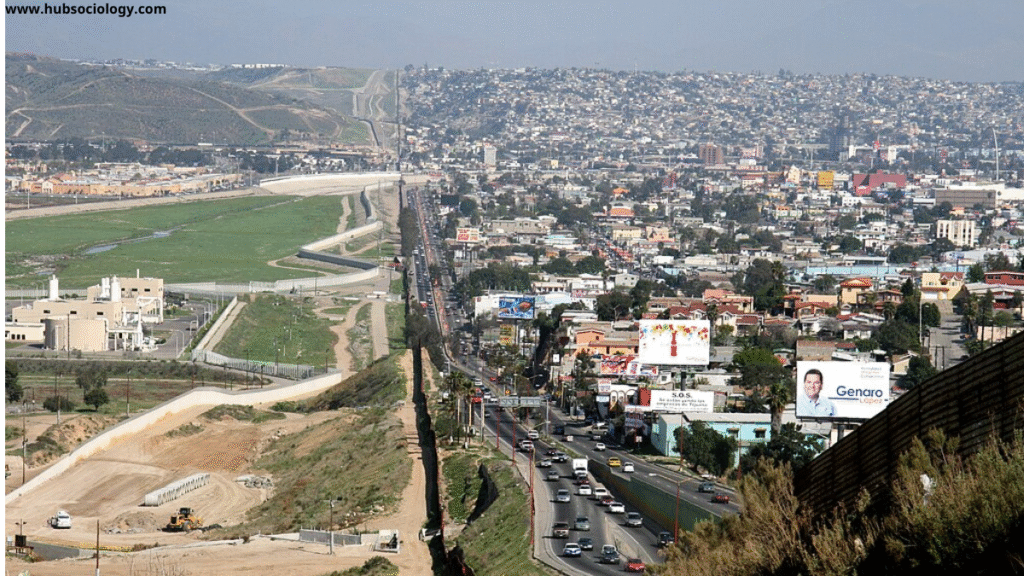Introduction
The U.S.–Mexico border is one of the most politically charged, culturally dynamic, and sociologically complex spaces in the world. Stretching nearly 2,000 miles from the Pacific Ocean to the Gulf of Mexico, it is not just a geopolitical boundary dividing two nations — it is a social, cultural, and economic frontier where globalization, migration, identity, and inequality intersect. Sociologists studying this region have coined the term “Border Sociology” to analyze how borders are socially constructed, lived, and experienced by individuals and communities.
Far from being a mere line on a map, the U.S.–Mexico borderland is a social landscape—a hybrid zone where Mexican and American cultures meet, mix, and clash. It embodies contradictions: openness and closure, inclusion and exclusion, opportunity and despair. This article explores the sociological significance of the U.S.–Mexico borderlands, examining key themes such as migration, identity, inequality, security, and resistance, while situating them within the broader framework of border sociology.

Understanding Border Sociology
Border Sociology refers to the study of borders not only as territorial demarcations but as social institutions that produce and reproduce power relations, cultural identities, and economic disparities. It explores how borders shape people’s lives, influence migration patterns, define citizenship, and maintain systems of inequality.
Sociologists like Gloria Anzaldúa, in her seminal work Borderlands/La Frontera: The New Mestiza, emphasized that borders are symbolic and psychological as well as physical. She described the borderland as a space of “in-betweenness”, where hybrid identities are formed amidst conflict and creativity. Others, such as Sandro Mezzadra and Étienne Balibar, view borders as processes rather than static lines, emphasizing that they extend far beyond their geographic location — into policies, labor markets, and everyday social relations.
Thus, border sociology focuses on how nation-states, globalization, and human agency interact to construct borders socially and materially. The U.S.–Mexico border provides a powerful case study for understanding these dynamics.
The U.S.–Mexico Borderlands: A Sociological Overview
The U.S.–Mexico border region has been historically shaped by colonialism, economic dependency, and migration. The 1848 Treaty of Guadalupe Hidalgo redrew territorial lines after the Mexican-American War, transforming Mexican citizens overnight into U.S. residents — creating a “border people” who would continue to navigate complex identities of nationality and belonging.
Today, the borderlands encompass major cities like Tijuana, Juárez, El Paso, and San Diego, each reflecting the intersection of two nations’ economies and cultures. Over 15 million people live in this transnational corridor, where Spanish and English blend, economies depend on cross-border trade, and social relations defy political demarcation.
Sociologically, the U.S.–Mexico borderlands illustrate:
- Cultural hybridity – creation of bicultural, bilingual communities.
- Social stratification – sharp inequalities in wealth, opportunity, and legal status.
- Transnationalism – movement of people, goods, and ideas across boundaries.
- Surveillance and securitization – increasing control mechanisms shaping human mobility.
Migration and Mobility
Migration is at the core of border sociology. The U.S.–Mexico border is the most frequently crossed international boundary in the world, representing both hope and hardship. For millions of Mexicans and Central Americans, it symbolizes the pursuit of economic opportunity, family reunification, or refuge from violence. Yet, the border has also become a site of death, danger, and criminalization.
From a sociological perspective, migration reflects structural inequalities between the Global North and South, rooted in economic systems like NAFTA (North American Free Trade Agreement), which displaced small farmers and workers in Mexico, driving many northward. Sociologist Douglas Massey highlights how U.S. labor demands, coupled with restrictive immigration policies, create a paradox: an economy that depends on undocumented workers but denies them legal recognition.
The border thus becomes a filtering mechanism — permitting the flow of capital and goods but restricting human mobility. Migrants face racial profiling, militarized patrols, and social stigma. The increasing militarization of the border since the 1990s — through operations like Gatekeeper and Hold the Line — reflects the securitization of migration, where the border serves to reinforce national identity and control rather than cooperation and integration.

Borderlands Identity and Cultural Hybridity
The borderland is not merely a place of separation but of cultural fusion. It is a site where Mexican, Indigenous, and American cultures coexist, clash, and merge. Sociologically, this hybrid identity challenges rigid notions of nationality, race, and belonging.
Gloria Anzaldúa’s concept of the “mestiza consciousness” captures this blending of worlds — a consciousness born of living in the borderlands, negotiating multiple identities. In border cities like Tijuana and El Paso, people move between two worlds daily, speaking “Spanglish,” celebrating both Mexican traditions and American modernity.
This hybridity manifests in:
- Language: Code-switching between Spanish and English as a cultural negotiation.
- Cuisine: Mexican-American dishes like tacos and burritos becoming global.
- Art and Music: Chicano art, border murals, and corridos that narrate border struggles.
Yet, this hybridity also comes with tension. Border residents often experience cultural marginalization — viewed as “too Mexican” in the U.S. and “too Americanized” in Mexico. The sociological significance lies in how identity is fluid, situational, and shaped by structural forces like race, class, and citizenship.
Gender, Race, and the Border Experience
The border affects people differently based on gender and race. Women migrants, especially from Mexico and Central America, face unique vulnerabilities — including sexual violence, exploitation in the maquiladora industries, and gendered discrimination in migration policies.
Sociological studies of feminization of migration show that women increasingly migrate independently for work, particularly in border factories producing for U.S. markets. These women labor under poor conditions with limited rights, reflecting a gendered global economy.
Moreover, race plays a central role in border governance. Latino and Indigenous identities are racialized within U.S. immigration discourse, where migrants are often portrayed as “illegal” or “threatening.” This racialization perpetuates xenophobia and systemic inequality, reinforcing the border as a social mechanism of exclusion.
The border thus functions as a gendered and racialized institution, regulating not only movement but also power and social status.
Economic Inequality and Labor Relations
Economically, the U.S.–Mexico borderlands reveal the stark inequalities between the two nations. The Maquiladora Program, launched in the 1960s, established factories along the Mexican side of the border where goods could be assembled cheaply for export to the U.S. While these industries created jobs, they entrenched a low-wage labor regime and environmental degradation.
Sociologically, this reflects the concept of “dependent development” — economic growth that sustains inequality by subordinating local economies to global capitalist interests. Workers in Mexican border cities labor for multinational corporations under exploitative conditions, while their counterparts across the border earn multiple times more for similar work.
This economic asymmetry fosters a transnational class system, where labor mobility is restricted but capital moves freely. The border thus becomes an economic mechanism maintaining global inequality while symbolically representing national security.
Securitization and the Politics of Fear
The sociological study of borders cannot ignore the rise of border securitization — the framing of migration as a national security issue. Especially since the 9/11 attacks, U.S. border policy has shifted toward militarization, surveillance, and deterrence.
Walls, drones, biometric systems, and detention centers have transformed the border into a “security theater.” This reflects what sociologist Didier Bigo calls the “ban-opticon” — a system that simultaneously bans, monitors, and disciplines mobile populations.
The wall itself — physical and symbolic — has become a political performance. It reassures citizens of control while deepening divisions and human suffering. Border sociology examines how fear and nationalism shape such policies, turning migrants into “others” and redefining citizenship as exclusionary.
Yet, sociological studies also reveal resistance and resilience. Migrant advocacy groups, humanitarian organizations, and transnational activists challenge these narratives, offering a counter-discourse rooted in human rights and solidarity.
Border as a Social Laboratory
The border is often seen as a microcosm of globalization — a social laboratory where the effects of free trade, migration, cultural exchange, and security intersect. It allows sociologists to study:
- How people construct meaning and identity in contested spaces.
- How global capitalism shapes local lives.
- How states and communities negotiate sovereignty and belonging.
In this sense, border sociology extends beyond the U.S.–Mexico case. It contributes to understanding other global frontiers — such as the India–Bangladesh border, the EU external borders, or Israel–Palestine — as spaces where similar processes of control, resistance, and hybridity occur.
Transnationalism and Border Communities
Sociologically, transnationalism — the maintenance of ties across national boundaries — is central to border life. Many families are binational, with relatives living on both sides of the border. Daily life involves crossing back and forth for work, education, healthcare, and shopping.
Remittances, bilingual education, and cross-border marriages all illustrate how borders fail to fully separate societies. Instead, they create transnational social fields, where individuals operate within two or more systems simultaneously. This challenges classical sociological notions of society as territorially bounded.
Environmental and Humanitarian Dimensions
Another sociological dimension is the environmental and humanitarian crisis unfolding in the desert regions of the border. Thousands of migrants have died attempting to cross, as enforcement pushes routes into harsher terrain. Sociologists and anthropologists document how state policies effectively create “spaces of death”, turning the natural landscape into a mechanism of control.
Environmental degradation from border infrastructure — walls disrupting wildlife migration, pollution from maquiladoras — further highlights how borders are ecological as well as social phenomena.
Humanitarian groups such as No More Deaths and Border Angels illustrate civil society’s role in resisting dehumanizing policies and offering aid. These efforts embody a sociology of care and resistance, revealing moral contestation at the border.
The Future of Border Sociology
As globalization accelerates and migration intensifies, border sociology is becoming a critical field for understanding the modern world. The U.S.–Mexico borderlands show that borders are not merely about exclusion but also about connection, creativity, and coexistence.

Future sociological research focuses on:
- Digital borders: How technology and data surveillance redefine mobility.
- Postcolonial analysis: How historical power relations shape border regimes.
- Climate migration: How environmental change will reshape borders.
- Human rights and solidarity networks: Emerging forms of global citizenship.
In this sense, border sociology contributes to reimagining the world beyond rigid nation-states — toward a more inclusive and humane global order.
Conclusion
The U.S.–Mexico borderlands, viewed through the lens of border sociology, reveal the deep interplay between power, culture, and human agency. This region is not just a political boundary but a social frontier, where globalization’s contradictions are laid bare. It embodies hope and hardship, hybridity and exclusion, control and resistance.
Sociologically, the border is a living organism — shaping and shaped by the people who inhabit it. It teaches us that borders are not only walls to divide but also bridges that connect. Understanding this dual nature is essential to addressing the humanitarian, economic, and cultural challenges of our globalized era.
Ultimately, the study of the U.S.–Mexico borderlands reminds us that while walls can mark territory, they cannot contain human aspiration, identity, and solidarity.
Do you like this this Article ? You Can follow as on :-
Facebook – https://www.facebook.com/hubsociology
WhatsApp Channel – https://whatsapp.com/channel/0029Vb6D8vGKWEKpJpu5QP0O
Gmail – hubsociology@gmail.com
15 FAQs on Border Sociology
1. What is Border Sociology?
Border Sociology is a branch of sociology that studies borders not just as physical boundaries between nations, but as social constructions that shape identity, migration, inequality, and power relations. It examines how people experience, negotiate, and resist the effects of borders in everyday life.
2. Why is the U.S.–Mexico border important for Border Sociology?
The U.S.–Mexico border serves as a key case study in Border Sociology because it highlights issues such as migration, cultural hybridity, economic inequality, and border militarization. It represents how globalization and national policies interact to affect human lives.
3. Who are some major thinkers associated with Border Sociology?
Prominent figures include Gloria Anzaldúa, who explored border identities in Borderlands/La Frontera, and theorists like Étienne Balibar, Sandro Mezzadra, and Thomas Nail, who conceptualized borders as dynamic social processes rather than fixed lines.
4. How does Border Sociology view borders differently from political science or geography?
While political science and geography often study borders as territorial or administrative lines, Border Sociology views them as social institutions that regulate inclusion and exclusion, shape identities, and reinforce power hierarchies within societies.
5. What is the sociological meaning of “borderlands”?
In Border Sociology, “borderlands” refer to the social and cultural spaces that exist around borders. These are hybrid zones where diverse populations interact, creating unique identities, languages, and social practices that transcend national divisions.
6. How does Border Sociology explain migration?
Border Sociology explains migration as a result of structural inequalities between nations, historical legacies like colonialism, and global capitalism. It also studies how border enforcement, policies, and social perceptions affect migrants’ identities and experiences.
7. What role does culture play in Border Sociology?
Culture plays a central role in Border Sociology. The borderlands are cultural melting pots, where new forms of art, language (like Spanglish), cuisine, and identity emerge — reflecting a blend of traditions and the tensions of belonging to multiple worlds.
8. How does Border Sociology address issues of identity?
Border Sociology explores hybrid identities formed in border regions, where people may identify with multiple cultures or nations simultaneously. It challenges rigid national identities and highlights “in-betweenness” as a sociological condition of modern life.
9. What is the connection between Border Sociology and globalization?
Border Sociology reveals how globalization increases the flow of goods, capital, and ideas, but also intensifies border control and inequality. It studies how borders both connect and divide societies in an era of global interdependence.
10. How does Border Sociology analyze power and inequality?
Borders reflect and reinforce power relations — determining who can move freely and who cannot. Border Sociology examines how states use borders to control populations, protect capital, and perpetuate global inequality, especially between the Global North and South.
11. How is Border Sociology relevant to contemporary social issues?
Border Sociology is relevant to current debates on migration, refugees, nationalism, and security. It helps explain the social consequences of border walls, deportations, and the growing divide between inclusion and exclusion in modern societies.
12. What is meant by the “securitization” of borders in Border Sociology?
Securitization refers to the process of framing borders as security threats, often justifying militarization and surveillance. Border Sociology studies how fear and nationalism are used to legitimize restrictive border policies and control human movement.
13. How does Border Sociology address gender and race?
Border Sociology analyzes how borders are racialized and gendered. Women and racial minorities often face disproportionate risks, violence, and discrimination at borders, revealing how migration and identity intersect with systems of oppression.
14. What research methods are used in Border Sociology?
Researchers in Border Sociology use ethnography, interviews, visual sociology, and transnational fieldwork to study life in border regions. They observe how people experience, adapt to, and resist the constraints of border regimes.
15. Why is Border Sociology important in understanding the modern world?
Border Sociology is essential because borders shape our world — defining who belongs, who moves, and who is excluded. It helps us understand the social, cultural, and moral implications of living in an era where globalization coexists with rising nationalism and border control.
